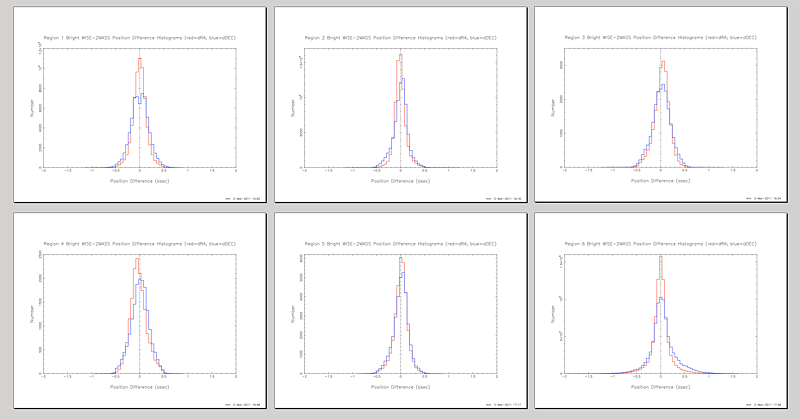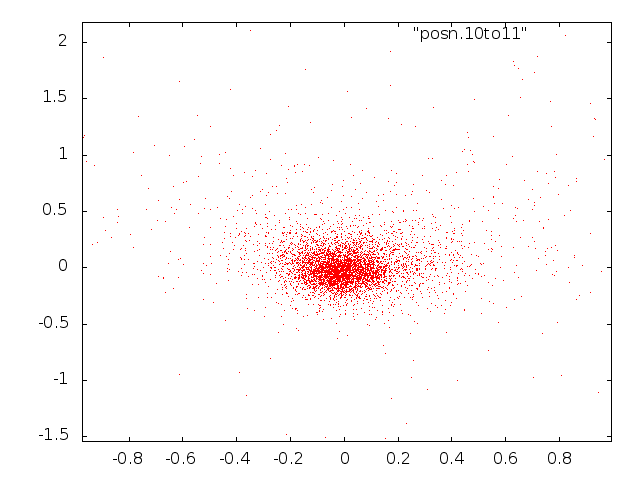 |
| Figure 1 - 2MASS vs. WISE position differences in R.A. (red) and Declination (Blue) for bright sources (W1<12.5). The RMS of these residuals is typically <0.2" |
"The root mean square error in WISE catalog positions with respect to 2MASS catalog positions shall be less than 0.5 arcsec, for sources with SNR > 20 in at least one WISE band, where the noise includes flux errors due to zodiacal foreground emission, instrumental effects, source photon statistics, and neighboring sources. This requirement shall not apply to sources that are superimposed on an identified artifact."
WISE astrometric solutions are tied to the 2MASS reference frames via WISE point source extractions in common with a bright, astrometrically clean subset of the 2MASS catalog (detailed in IV.3.d; see also the 2MASS astrometric reference sample, 2MRef). Since the flux limit for 2MASS was brighter than that of WISE, every WISE image typically contained hundreds of these 2MASS positional references. 2MASS positions for bright sources are precise to <0.1 arcseconds relative to the ICRS reference frame (see the 2MASS Explanatory Supplement, section VI.6.a). As a result, the reference frame for WISE astrometry is rigid and precise around the sky. Since the WISE Source Catalog includes positional associations with 2MASS as well as positional differences between WISE and 2MASS via the Catalog columns r_2mass and pa_2mass, the quality of WISE astrometry can be validated to first order from these Catalog columns. Only three free parameters (two translation + rotation) are fit for each Single-exposure frameset (band-to-band offsets, plate scales and distortion are priors determined from off-line analysis). If there were only two or three 2MASS matches found in a frame, using the post-fit WISE-2MASS differences as a measure of WISE source position accuracy would not be meaningful However, given that there are typically several hundred matches per frame the differences do provide a meaningful measure of that accuracy.
Figure 1 shows histograms of 2MASS vs. WISE delta-RA and delta-Dec for bright (W1<12.5) WISE sources from several test regions that lie within the WISE Preliminary Data Release area. The positions of these bright WISE sources is not adopted directly from the 2MASS position but derived from a full solution to the WISE frame. The FWHM of these histograms is typically <0.2" demonstrating that the astrometric residuals for bright WISE sources surpass the the Level 1 requirement of RMS<0.5".
 |
| Figure 1 - 2MASS vs. WISE position differences in R.A. (red) and Declination (Blue) for bright sources (W1<12.5). The RMS of these residuals is typically <0.2" |
Figure 2 presents the same WISE vs. 2MASS positional difference histograms for fainter magnitudes (13.5<w1<14.0). The declination distributions in these plots are broad and often substantially asymmetric indicating that a declination astrometric bias has been introduced for these fainter sources. The histograms show that the declination coordinate was affected by this bias while the right ascension shows little bias. The RMS of the right ascension distribution is similar to that for brighter sources. Figure 3 animates the position differences between 2MASS and WISE sources as a function of W1 magnitude in one-half magnitude steps for a field that contains Messier 67. Bright sources (W1<13.0) show little or no declination bias. Beginning at W1~13.0 mag the number of sources showing a significant declination bias increases.
 |
| Figure 3 - 2MASS vs. WISE position differences in two dimensions animated as a function of W1 magnitude. |
Figure 4 shows how the population of biased sources grows with increasing W1 magnitude in the M67 test field. Figure 5 shows the selection criteria used in Figure 4 for identifying a biased source. Faintward of W1~14.5 the astrometric uncertainty associated with source extraction becomes large enough that this simple metric becomes biased from sources with excessive uncertainties.
Because WISE scanned the sky along lines of approximately constant ecliptic longitude, the bias in declination indicates a pipeline processing error. Indeed, the WSDS profile-fit photometry code (WPRO) that deblended stars with overlapping point spread functions contained an error that caused the reporting of an incorrect declination position. The error effectively randomly selected sources for blended pairs and zeroed the calculated declination offset of one of the sources relative to the pair's centroid. This bias affected only blended sources, explaining the increased population of sources with erroneous positions toward fainter magnitudes. The erroneously zeroed offset was equal to one half the size of a coadd pixel, or 0.675". The effects of smoothing during the coadd process resulting in an astrometric offset typically ~0.5" with an approximately Gaussian envelope of FWHM~0.5"
Sufficient time was not available prior to the WISE Preliminary Data Release to reprocess the release dataset to correct the declination bias. Instead, the declination uncertainty column, sigdec, of the Release Source Catalog and Single-exposure Source Database tables, has been revised to account for a larger uncertainty in the reported declination coordinate. To provide a catalog with tabulated errors that reflect the actual errors, the reported declination uncertainties (sigdec) have been inflated by
Thus, the reported value of sigdec includes an additional 0.5" uncertainty root-summed-squared with the pipeline-derived value of sigdec (which, despite the bias introduced by the pipeline coding error in the declination coordination, has a value consistent with the source extraction uncertainty). The value of 0.5" makes the median absolute deviation (MAD) of the declination difference between 2MASS and WISE for the faint portion of the 2MASS-WISE cross-matched sample have the value 0.6745σ expected for a Gaussian.
IMPORTANT CAVEAT: Users conducting studies based on the WISE Preliminary Release positions should note that the distribution of true position residuals relative to the ICRS, as illustrated by comparison with 2MASS (Δδ) is not Gaussian (Figures 2 and 6). This fact means that probability ranges for this position difference will not scale as they would for a Gaussian. For example, the 95% range will not be 2.906*MAD as it for a Gaussian. Furthermore, the distribution of Δδ varies with source brightness and with position on the sky.
HOW TO DO BETTER: The WISE vs. ICRS/2MASS declination position distribution, Δδ, is skewed so it is possible to cut the declination uncertainty nearly in half by using the actual distribution of Δδ appropriate for the magnitude and sky position of a source of interest. One approach entails performing a cone search of the Catalog centered on the target in a W1 magnitude range chosen to match the SNR of the target. For example, the WISE source WISEP J022058.58+620236.4 has W2=13 mag and is basically undetected in W1. Objects with a W1-W2 color of 1 have equal SNR in both bands. A cone search of sources with W1~14 mag within radius 3600 arc-seconds of the target will produce a distribution of WISE-2MASS declination residuals (Δδ=cos(pa_2mass)*r_2mass. One can fit the resulting histogram as the sum of two Gaussians, which is generally a good fit to the dec error distribution. This histogram can then guide an evaluation of the likelihood of a positional match, the error in a proper motion, or where to place a spectrograph slit on the sky. Figure 6 shows the results of this procedure for WISEP J022058.58+620236.4.
Overall, users should be aware that:
Although there are a large number of 2MASS associations for each coadd image, the majority of WISE sources have no 2MASS counterparts (Figure 8). Simple co-add overlays of reported source position can provide a first order check that the pipeline is properly transferring the astrometric solution derived from the brighter sources to the fainter ones. Inspection of such overlays (Figure 9) show that faint WISE source positions are well aligned with the images and thus that the faint source astrometric frame is properly adopted from that registered by the brighter sources.
The astrometric position for each WISE source is a weighted combination of information from all four WISE bands. The predominant tie between 2MASS and WISE, however, exists via sources detected in W1 and to a lesser extent in W2, since the sources in common are primarily stars. Sources detected by WISE in W3 and W4 only must inherit an astrometric solution driven by these bluer sources. The WISE Science Team is conducting follow-up studies of sources that are undetected in the W1 and W2 bands. These W3/W4 only sources tend to have fluxes close to the SNR=20 limit where WISE astrometry is expected to be better than 0.5" RMS. Figure 10 shows WISE vs. Spitzer IRAC position difference for ~400 of these W1/2 dropout sources. The RMS of this distribution is 0.66" in R.A. and 0.44" in declination.
The WISE-reported positions of sources brighter than W1<13.0 mag exhibit one-sigma residuals with respect to the 2MASS Point Source Catalog reference frame of <0.2 arcseconds in Right Ascension and Declination.
Approximately 20% of the sources fainter than W1~14.5 mag in the Preliminary Release Source Catalog and Single-exposure Source Database suffer from a pipeline coding error that biases the reported position by ~0.2-1.0" in the declination direction while an increasingly smaller fraction of the sources suffer this effect to magnitudes as bright as W1~13.0 mag. Reliable positions may be extracted from the Atlas Images, however the WCS of Atlas Images is also biased by up to 0.5" in W1, W2, W3, and 1.4" in W4 relative to the true astrometric reference frame owing to the shape of the point-spread-functions used for source extraction and centroiding. Both of these systematic errors will be corrected in WISE second-pass data processing.
Last update: 2011 April 26